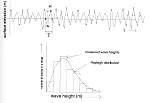Chapter 2: The impact of the sea
2.2 Waves (1)

| European Coasts - An Introductory Survey Chapter 2: The impact of the sea 2.2 Waves (1) |
|
 |
 |
 |
| Fig 37: Tidal gulies in the Venice Lagoon | Fig 38: Definition of a sinusoidal wave | Fig 39: The distribution of a measured irregular wave field |
Wave definitions; sinusoidal waves
The waves observed at the coast are wind-generated waves. Wave generation is due to wind stresses on the water surface. The waves grow with increasing wind speed, increasing duration of the wind and increasing
length of the generation area (fetch). When the wind stops, the waves keep travelling as swell.
Waves are defined by the wave height, the wave length and the wave period (see Fig. 38). The wave length is the distance between two wave crests. The wave height is the vertical distance between the wave crest and the wave trough. The wave period is the time that passes between two consecutive wave crests being at a given point. The water particles perform orbital motions (circles for deep water, ellipses for shallow water).
Knowledge of linear sinusoidal wave theory is essential for understanding coastal processes. Although waves on the water surface are seldom sinusoidal, linear wave theory gives a good insight into the physical behaviour of waves. In the case of sinusoidal waves, there is no resulting mass transport of water particles while the waves propagate (particle orbits are closed). In reality, mass transport is an important phenomenon in the shallow water along the coasts.
previous page table of contents next page
| This page is from the book "European Coasts", produced in the framework of the Erasmus project under EC contract ICP 92-G-2013 and placed on the Internet in the framework of the PIANC-MarCom initiative on Education. |